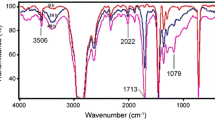Abstract
Differential thermal analysis (DTA) and infrared (IR) spectroscopy have been used to investigate the effects of an antioxidant (neozone D) and an oxidation catalyst (dispersed copper) on polyethylene melt oxidation under nonisothermal conditions (samples were heated at a constant rate). An increase in the content of the antioxidant or the oxidation catalyst gives similar results: a decrease in the thickness of the oxidized surface layer and accordingly in the total amount of oxidation in polyethylene samples. This is due to an increase in the rate of oxidation of the polymer.
Résumé
Etude par ATD et par spectroscopie infrarouge (IR) de l'effet de la teneur en antioxydant (Néozone D) et en catalyseur d'oxydation (cuivre dispersé) sur l'oxydation du polyéthylène fondu, en conditions non isothermiques (échauffement des échantillons à vitesse constante). L'augmentation de la teneur en antioxydant ou en catalyseur d'oxydation donne des résultats similaires, c'est-à-dire une diminution de l'épaisseur de la couche superficielle oxydée, et, par suite, de la quantité oxydée totale des échantillons de polyéthylène. Ceci est dû à l'augmentation de la vitesse de l'oxydation du polymère.
Zusammenfassung
Differentialthermoanalyse (DTA) und Infrarotspektroskopie (IR) wurden zur Untersuchung der Wirkung des Gehaltes an Antioxidantien (Neozone D) und Oxidierungskatalysator (dispergiertes Kupfer) auf die Oxidation von Polyäthylenschmelze unter nicht-isothermischen Bedingungen (unter Aufheizung der Proben mit konstanter Geschwindigkeit) eingesetzt. Die Zunahme des Gehaltes an Antioxidanz oder Oxidierungskatalysator ergibt ähnliche Ergebnisse, d. h. Herabsetzung der Stärke der oxidierten Oberflächenschicht und, dementsprechend, der Gesamtoxidationsmenge in den Polyäthylenproben. Dies ist der Zunahme der Oxidationsgeschwindigkeit des Polymers zuzuschreiben.
Резюме
Дифференциальный те рмический анализ (DTA) и инфракрасная спектр оскопия (IR) были использованы дл я исследования влиян ия содержания антиокис лителя (неозон D) и катализатора окисл ения (диспергированн ая медь) на окисление расплава п олиэтилена в неизотермических у словиях (образцы были нагреты при постоянной скорости). Увеличение содержания антиокис лителя или катализат ора окисления дает одина ковые результаты, главным образом, умен ьшение толщины окисл енного поверхностного слоя и, согласно этому, умень шение общего количес тва окисленного продукт а в полиэтиленовых образцах. Это обуслов лено увеличением ско рости окисления полимера.
Similar content being viewed by others
References
V. V. Edemskaya, V. B. Miller andYu. A. Shlyapnikov, Reports of AS USSR, 196 (1971) 1121.
”Aging and Stabilization of Polymers” (edited by M. B. Neiman), Nauka, Moscow, 1969, p. 332.
Polyethylene and Other Polyolefines (edited by P. V. Kozlov, N. A. Platè), Mir, Moscow, 1964, p. 321.
B. Baum, J. Appl. Polymer Sci., 2 (1959) 281.
E. M. Bevilacqua, E. S. English andJ. S. Gall, J. Appl. Polymer Sci., 8 (1964) 1691.
Z. Wolkober andE. Kovács, in “Kinetics and Mech. Polyreacts”, Preprs., Budapest, 1969, Vol. 5, p. 389.
V. V. Edemskaya, B. A. Gromov, V. B. Miller andYu. A. Shlyapnikov, Vysokomolekul. Soedin., (High Molecular Weight Compounds), 10B (1968) 706.
N. I. Egorenkov, D. G. Lin andV. A. Bely, Reports of AS BSSR, 16 (1971) 1012.
N. I. Egorenkov, D. G. Lin andV. A. Bely, Reports of AS USSR 214 (1974) 1376.
N. I. Egorenkov, D. G. Lin andV. A. Bely, Reports of AS USSR, 207 (1972) 397.
New Methods for Polymer Investigations, (edited by Bacon Ke), Mir, Moscow, 1966, p. 332.
M. M. Kalnin andV. P. Karlivan, Vysokomolecul. Soedin., (High Molecular Weight Compounds), 10A (1968) 2335.
N. I. Egorenkov, D. G. Lin andV. A. Bely, Reports of AS USSR, 223 (1975) 154.
V. S. Shifrina andN. N. Samosatskii, Polyethylene, Khimia, Leningrad, 1961, p. 94.
Ya. Yu. Bal'tenene andR. A. Bal'tenas, Polymer Materials and their Investigations, 1971, Vol. 2, p. 20.
S. G. Kiryushkin andYu. A. Shlyapnikov, Vysokomolekul. Soedin. (High Molecular Weight Compounds), 16B (1974) 350.
N. M. Emanuel', G. E. Zaikov andZ. K. Maizus, Role Played by the Environment in Radical-Chain Reactions of Oxidation in Organic Compounds, Nauka, Moscow, 1973, p. 279
E. K. Rideal, Heterogeneous Oxidation of Hydrocarbons, Mir, Moscow, 1971.
Author information
Authors and Affiliations
Rights and permissions
About this article
Cite this article
Egorenkov, N.I., Lin, D.G. & Belyi, V.A. DTA investigation of inhibited and catalyzed oxidation of polyethylene. Journal of Thermal Analysis 10, 357–362 (1976). https://doi.org/10.1007/BF01909886
Received:
Issue Date:
DOI: https://doi.org/10.1007/BF01909886




